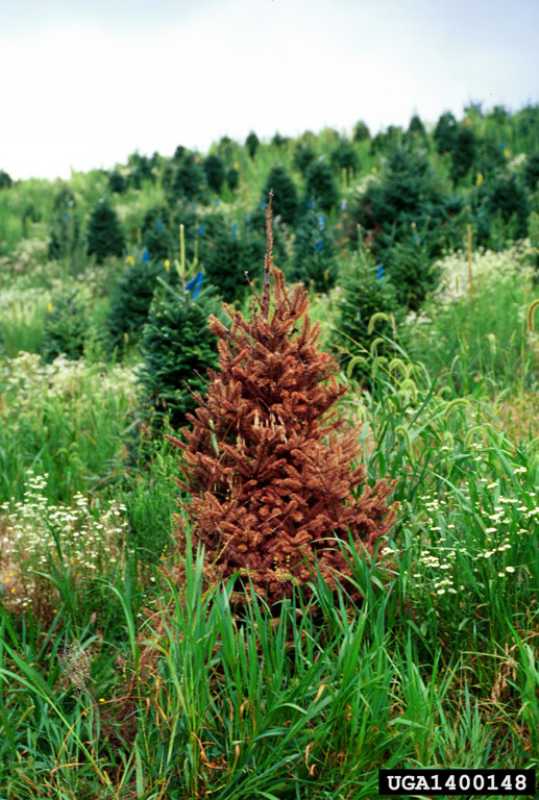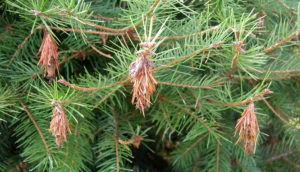Cicadas are Here, There and Everywhere (Depending where you are): 17 year cicadas began emergence last week. These insects while a marvel in the insect world, are also capable of doing considerable damage to young fruit trees, grape vines, and blueberry bushes. After mating they begin to deposit their eggs in slits along small diameter branches. Thin branches which are loaded with fruit weight and damaged by egg laying can break. Some growers have asked about damage and what they can do to prevent it. Most egg laying is starting this week.
Immediate potential for boxwood blight in many parts of NJ over the next 4 days
Breaking- Due to the potential for rainfall and high humidity levels, there is an immediate risk of boxwood blight infections in many parts of New Jersey. Be mindful that even though we have had very little precipitation in the state as of late, we are well within the boxwood blight growth range and prior cover-sprays may have been washed off by irrigation or the interval to reapply has come due.
Preventative spray programs should continue or be initiated for high value crops or installations.
| Boxwood Blight Risk Assessment as of 5/26/2021 | ||||||||
| Region | Location | CODE | 26-May | 27-May | 28-May | 29-May | 30-May | 31-May |
| Southern | Upper Deerfield | NJ50 | Infection Risk | Infection Risk | Very Low | Low | Very Low | Very Low |
| Central | Howell / Freehold | NJ10 | Low | Infection Risk | Very Low | Low | Very Low | Very Low |
| Northern | High Point | NJ59 | Very Low | Very Low | Very Low | Very Low | Very Low | Very Low |
| Please check your local boxwood blight risk here (click here and type in your area code – select closest station) | ||||||||
These advisories are general in nature and change rapidly so someone from your business should be using this risk model (CLICK HERE) daily if boxwood is important to your financial stability – In 30 seconds you can have a better idea of boxwood blight (and other pathogen) activity in your immediate area!
- (click on the link – input area code – select closest weather station – check 7-14 prediction – click on graph / table)
Fungicide options;
- You very well may have these materials already applied as ‘cover-sprays’ – But – be mindful that protectant fungicides lose efficacy the more rain/irrigation they are subjected to, and reapplication may be warranted especially if the reapplication interval has come due.
- ROTATE between Fungicide Resistance Action Committee (FRAC codes) whenever possible
Format: [FRAC code]: Chemical name (Trade names)
- [M05]: Chlorothalonil (Daconil WS)
- [M05 + 1] Chlorothalonil + Thiophanate methyl (Spectro 90WDG)
- [11] Trifloxystrobin + [7] Fluopyram (Broadform)
- [11] Trifloxystrobin + [3] Triadimefon (Armada 50WDG)
- [M03] Mancozeb
- [12] Fludioxonil (Medallion WDG)
- [3] Tebuconazole (Torque)
DISCLAIMER: The label is the law, always refer to it for allowable host crops, use-restrictions, application rates, reapplication intervals, re-entry intervals (REI), and mix compatibility information. Production and pesticide information on this site are for private/commercial pesticide applicators and landscape professionals only, and are NOT for home gardener use. Provided materials represent examples and do not cover all possible control scenarios. Trade-names listed do not imply endorsement and are used as examples only. Please contact your local agent or chemical sales representative for more information or to discuss additional pest management options.
Do you have Phytophthora at your conifer nursery / Christmas tree farm? We are still looking for a few more participants in a statewide study – aimed at better RECS.

Tim Waller (Cumberland Co.) and Bill Errickson (Monmouth Co.) of Rutgers Cooperative Extension are looking for 30 conifer producers to collaborate in a statewide Phytophthora sampling project, as part of a Specialty Crop Block Grant. This study will focus on identifying the species of Phytophthora limiting conifer production in New Jersey.
- If your operation is selected, the agents will schedule one to three visits this growing season to collect samples from roots, bark, soil, irrigation systems, and will perform soil testing (Year 1).
- During years 2 and 3, we will be performing chemical, biological, and cultural disease management trials in addition to conifer variety trials, at Rutgers-NJAES experiment stations. The aim is to generate local data – using local isolates in order to develop a more wholistic set of recommendations when targeting this disease in our NJ nurseries.
The agents also look forward to developing stronger relationships throughout New Jersey in the post-COVID19 era
This project is open to nurseries and Christmas tree farms producing conifers in NJ
If you are interested in this project – please respond via this brief survey (click here)
Please print and share this PDF survey with anyone not online (click here)
Please contact Tim Waller – twaller@njaes.rutgers.edu – (856-451-2800) – for more information
Landscape Pest Notes: Some Late-Spring Insects (Part 2)
Since there are still over 4-weeks before the official start of summer, the accumulation of growing-degree-days (GDD) will continue to accelerate over the next several weeks. Many of our landscape insect pests will be rapidly emerging and be entering their best control windows before they potentially cause feeding symptoms. This writing contains part 2 of 2 parts of only a handful of the many late spring landscape insect pests that require monitoring. Some could more properly be called mid-spring pests, especially in southern NJ. Those included within part 2 of this blog are: Taxus mealybug; Boxwood leaf miner; Aphid species and Bronze birch borer.
Landscape Pest Notes: Some Late Spring Insects (Part 1)
Since there are still nearly 5-weeks before the official start of summer, the accumulation of growing-degree-days (GDD) will continue to accelerate over the next several weeks. Many of our landscape insect pests will be rapidly emerging and be entering their best control windows before they potentially cause feeding symptoms. This writing contains part 1 of 2 parts of only a handful of the many late spring landscape insect pests that require monitoring. Some could more properly be called mid-spring pests, especially in southern NJ. Those included within part 1 of this blog are: Four-lined plant bug; Douglas-fir needle midge; Pine needle scale; & Elongate hemlock scale.
It is time to put Bagworms on your radar in Southern NJ

Photo: Rich Buckley
Bagworms should begin hatching in the next 2-6 weeks throughout NJ, starting in the southern regions. Now is an optimal time to get this pest on your radar and prepare materials or approaches to attack first/second instar caterpillars. The control window for this pest is typically between 600-900 GDD50 (growing degree-days) and treatments should be in use prior to their mobile, airborne, “ballooning” phase. Check that the eggs have hatched prior to application of pesticides – as most compounds will not be effective at all if the first instar caterpillars are not present. Lethal pesticide doses are important, as sub-lethal doses can trigger early pupation, making the pest all but invincible to chemical or biological treatments.
Bagworm management – mechanical: If eggs have not hatched: hand-remove sacs/bags. Typically female/egg filled sacs are higher in the canopy so keep that in mind while scouting.
Treatment options for Lepidoptera (caterpillars) to have at the ready – containing: B.t. (Bacillus thuringiensis)(Dipel), spinosad (Entrust SC), bifenthrin (Talstar, UP-Star), cyfluthrin (Decathlon 20WP), carbaryl (Sevin SL), chlorantraniliprole (Acelepryn), cyclaniliprole (Sarisa), cyclaniliprole + flonicamid (Pradia), Lambda-cyhalothrin (Scimitar GC), cyantraniliprole (Mainspring), Indoxacarb(Provaunt)
IT IS CRITICAL TO ROTATE AS MUCH AS POSSIBLE BETWEEN IRAC GROUPS DUE TO THE NUMBER OF POTENTIAL APPLICATIONS
DISCLAIMER: The label is the law, always refer to it for allowable host crops, use-restrictions, application rates, reapplication intervals, re-entry intervals (REI), and mix compatibility information. Production and pesticide information on this site are for private/commercial pesticide applicators and landscape professionals only, and are NOT for home gardener use. Provided materials represent examples and do not cover all possible control scenarios. Trade-names listed do not imply endorsement and are used as examples only. Please contact your local agent or chemical sales representative for more information or to discuss additional pest management options.
More information on Bagworms:
Steve Rettke’s 2020 PPA Post – Bagworm caterpillars have hatched throughout most of NJ
Bagworms on Ornamental Landscape Plants
Photo Credits: Rich Buckley (Plant Diagnostics Laboratory) https://njaes.rutgers.edu/plant-diagnostic-lab/

